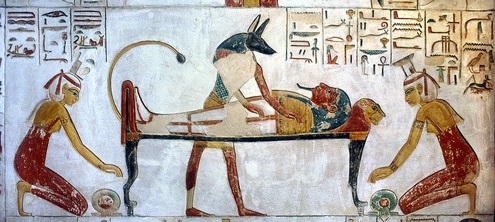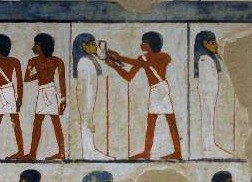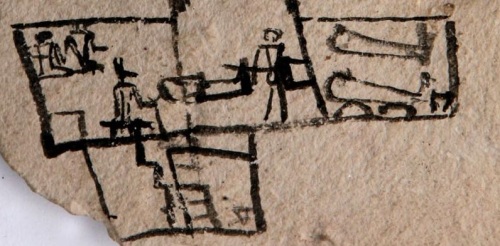
Ostracon with funerary scene. New Kingdom. Manchester Museum.
Last week we could read about ostracon 5886 in Manchester Museum. In that skecht the Egyptian artists represented what happened outside the tomb. Let’s see now what happened inside.
Inside the tomb, a man is descending and some others appear in the funerary chamber carrying the coffin. But there are two important things: a man with a jackal head is next to the corpse and two kneeling figures are in a corner of the chamber.
Acccording to Campbell Price the coffin would be being placed into the tomb, which is completely true. But was it necessary for placing the coffin a man with a jackal-headed mask and those two kneeling figures?
The schematic scene would in fact represent what happened inside the tomb for reviving the deceased. We have already seen that the Egyptian Opening of the Mouth ceremony would happen inside the tomb and that the two mourners in the role of Isis and Nephtys were a part of the party making a mourning rite in favour of the mummy.
The man with the jackal-headed mask as a living image of Anubis would play the role of the embalmer. In our opinion these two kneeling figures would be the two representatives of Isis and Nephtys. In fact the scene shows the members of the common Egyptian scene in which Anubis assists the mummy while Isis and Nephtys are (standing or kneeling) at both ends of the corpse. The difference here is that these ones stay apart in the chamber and already with their short hair.

Isis and Nephtys at both extremes of the corpse with shen rings. Tomb of Siptah. XIX Dynasty. Valley of the Kings. Photo: http://www.thebanmappingproject.com
The man on the right seems to hold with his hand a long straight object, which seems to be more similar to a kind of strike than to an incense burner, Could we consider it as the adze used in the Opening of the Mouth ceremony?

Opening of the Mouth ceremony from the tomb of Menna in Gourna. XVIII Dynasty. Photo: http://www.osirisnet.net
Both men are holding the mummy as if they wanted to place it down in the shaft after having finished the rites.
It does not seem too ridiculous to think that such schematic skecth would represent the end of the Opening of the Mouth ceremony and the moment in which the mummy is finally buried. Meanwhile the two professional mourners in the role of Isis and Nephtys would wait kneeling and already with no mane of hair until the dead is placed in the burial place and the shaft is sealed.
While that was happening inside the tomb, outside the common mourners would be lamenting, three of them with raise arms and one of them with hair on her face and her arms hanging down.

